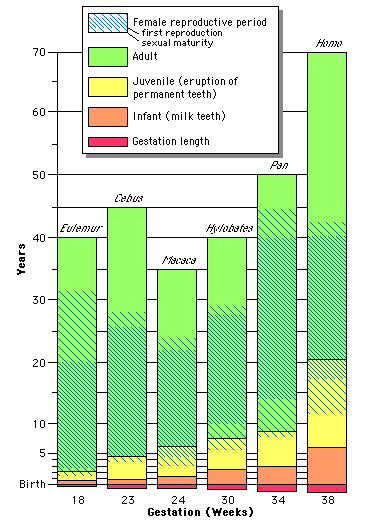Back to the Introduction index
![]() German version
German version
7. Ontogeny |
Back to the Introduction index
![]() German version
German version
7. Ontogeny |
Gibbons produce single offspring; twins are very rare (Dal Pra & Geissmann,
1994; Dielentheis et al., 1991; Geissmann, 1989). Gibbon birth weights (mean ±
standard deviations) are 406±55 g (n=7) for the genus Hylobates, 487±87
g (n=3) for Nomascus, and 551±88 g for Symphalangus (Geissmann
& Orgeldinger, 1995). The differences in birth weights between the genera parallel
those observed in adult body weights. No birth weights are available for Hoolock
but, to judge by adult body weights, those can be expected be similar to the birth
weights of Nomascus.
Gestation length in all gibbons appears to be around 7 months (Geissmann, 1991),
but no data are available for Hoolock.
Like other hominoids, gibbons exhibit relatively long pre-adult developmental phases
(Figure 7.1).

Figure 7.1. Comparison of the timing of life history events in several primates (after Fleagle, 1999, p. 41 and Schultz, 1972, p. 193, modified).
Based on zoo and field observations, gibbons of the genus Hylobates are
thought to reach sexual maturity at about 6 to 8 years of age, and Symphalangus
at about 8 to 9 years. The timing of this event may be rather flexible, however,
at least in captive animals. Male zoo gibbons of Nomascus and Symphalangus
can breed at the age of 4 and 4.3 years of age, respectively. Similarly, females
of Hylobates and Symphalangus can breed at 5.1 and 5.2 years, respectively
(Geissmann, 1991).
At least for zoo studies, the following age classes for captive gibbons (all genera)
are recommended (Geissmann, 1993): infants from 0 to 2 years of age; juveniles >2
to 4 years, subadults >4 to 6 years; adults more than 6 years. In wild gibbons,
maturation may occur slower on average.
The maximum life span of captive gibbons can reach about 48 years. The lifespan of
wild gibbons may reach 25 to 35 years (estimate), but comparative data of wild gibbons
are not available.
Immature individuals of some gibbon species may undergo several conspicuous changes
in their fur coloration and their song repertoire during their development. This
is shown here in the example of crested gibbons (Nomascus).
In crested gibbons, adult females exhibit a light yellowish or beige fur coloration
with a black cap, whereas adult males are black (in some species, males have light
cheek patches) (Figure 7.2). All crested gibbons are born with a yellow natal coat,
which resembles the coloration of adult females (minus black cap). Already near the
end of their first year of life, all immature crested gibbons change to a black coat,
which is virtually identical to that of adult males. Only about when attaining sexual
maturity, young females change fur coloration a second time and assume the yellowish
coat typical of adult females.

Figure 7.2. Changes in fur coloration in crested gibbons (genus Nomascus):
a.) Young adult pair (N. gabriellae). The male is almost completely black, the female is almost completely yellow.
b.) Adult female (N. leucogenys) with neonate offspring. All immature crested gibbons have yellowish fur at birth and change to black fur coloration only at the age of several months.
c.) Subadult female (N. gabriellae) during the phase of fur coloration change. When attaining sexual maturity, only the females change from the black juvenile coat to the adult yellow fur coloration. This change may take several months, during which the females become increasingly lighter in coloration and during which they may exhibit very distinct transitory coats. This female is nearly 5.5 years old. Her fur coloration is mostly gray, but already exhibits purely yellow areas on the chest and above the ears. The contrasting black cap typical of adult females is also becoming visible in this individual. (Photographs: T. Geissmann; Zoo Leipzig; Ménagerie du Jardin des Plantes, Paris; and Hong Kong Zoo).
Similarly dramatic changes in fur coloration also occur in hoolocks (Hoolock) and in the pileated gibbon (Hylobates pileatus). In other gibbons, changes in fur coloration are much less conspicuous (H. agilis, H. lar, H. moloch, H. muelleri) or completely absent (H. klossii, Symphalangus syndactylus).
Immature crested gibbons participate in the songs of their parents even during
their first year of life. Interestingly, they exclusively produce short great call-like
phrases until they are sexually mature. In adult gibbons, great calls are female-specific
phrases. Immature gibbons usually utter their great calls together with those produced
by their mother. About at the time they attain sexual maturity, the maturing males
change their repertoire and begin to sing male phrases.
This change in song repertoire appears to occur in all gibbon species. In some species,
however, immature gibbons appear to participate less often in the songs of their
family group and the change may then be less conspicuous.
During several years of their life, all young crested gibbons look like adult males but sing like adult females. These immature gibbons continuously provide a paradox information about their sex. This specialization appears to be unique among mammals. The ultimate causes for this feature are unknown. Possibly, young gibbons reduce their sexual attractiveness by emitting these contradictory signals. This may reduce the risk of incest as long as the offspring stay in their natal group. In addition, the contradictory signals may reduce the probability that the parents will consider their maturing offspring as competitors and permit the offspring to stay longer in their natal group. Unfortunately, very little is known about these ontogenetic phenomena.